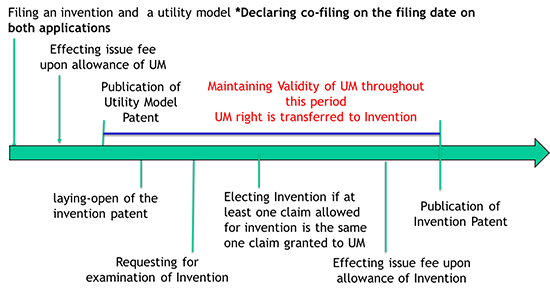Parallel Filing Strategy for
China and Taiwan
published on 2 Aug 2017
An applicant interested in acquiring an invention patent protection over its valuable R&D result may worry that its invention has been laid open but has not yet been entitled to an enforceable IP right because of the time-consuming substantive examination. If temporal protection may be available for the applicant’s invention in the form of a utility model, which is generally granted in a few months after formality examination, it would optimize the patent protection mechanism by filling up said protection-free gap. Such a demand has lead to the formation of “parallel filing.”
As Two National Filings
Taking a “parallel filing” route to file both an invention patent and a utility model application direction to a common inventive idea is permissible in either China or Taiwan. The procedural and substantive pre-requisites as well as the consequences at law are largely the same. To take advantage of parallel filing, both invention patent and utility model applications have to be filed by the same applicant(s), on the same date, directing to the same inventive idea, and with a declaration made on each respectively. In this way, the earlier-granted utility model may be continuously valid. In more detail each of the five prerequisites are set forth as follows:
- Same applicant(s): the ownership for two applications remains identical upon the time of filing, election (selecting either the effective utility model or granted invention patent), allowance of invention, grant and publication of invention.
- Same date:
A. CN: the same actual filing date; or
B. TW: the same actual filing date or the priority date, if any.
- Same inventive idea: at least one claim is the same.
- A declaration: made respectively on the utility model and invention patent application noting the co-filing of the other.
- Continuously valid: the earlier granted utility model is not extinguished or invalidated before allowance of the invention patent.
By satisfying the above prerequisites, upon the allowance of an invention patent application the applicant will be required either to elect invention patent application or to keep with the already granted and effective utility model (Note: parallel filing is not an exception to double patenting). Upon electing the invention patent, which enjoys a longer term of protection, the utility model shall be terminated upon the grant of invention, and, most significantly, the effectiveness of patent right will be seamlessly transferred, or relayed, from the utility model to the invention patent.
For the absence of a declaration on both or either one of the two applications upon filing, parallel filing route is not eligible. Assuming a utility model granted earlier, the invention application having at least one claim substantively identical will not be allowed eventually. In another situation where claim identity is found during pendency of both applications before the grant of either one, the applicant is obliged to elect. Failure to elect leads to rejection of both applications.
Note the applicant has a last resort to keep both cases, if desired. By amending the pending claims so that the two claim sets become substantively different, the applicant will be able to have both valid utility model and invention patent.
A time line visualizing parallel filing procedural is illustrated as follows.

Notable Matters for PCT Entering China National Phase Scenario
P.R. China is a contracting party to the PCT. An applicant can enter a PCT, or international application in the China national phase for obtaining a Chinese patent. However, a PCT application is not eligible for the parallel filing strategy.
As explained, to enjoy the benefit of “relaying” two patent rights, the two applications have to be filed on the same “actual filing date” at SIPO, regardless of their priority dates being the same. Presumably an applicant would only file a PCT application first in considering a larger plan for global filing. Later the applicant may file another national application in China and in the meantime considering using the parallel filing route. The PCT and Chinese national applications could not possibly enjoy the same filing date. Furthermore, the applicant is de facto unable to state a parallel Chinese national application at the time of PCT filing. The aforementioned “declaration” prerequisite has not been satisfied.
for any questions relating to this topic, please contact us at cjchen@tsailee.com.tw
|